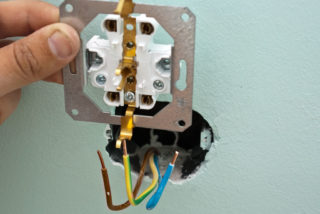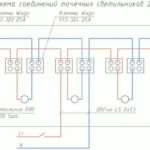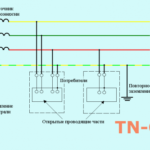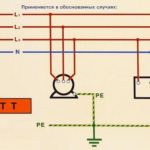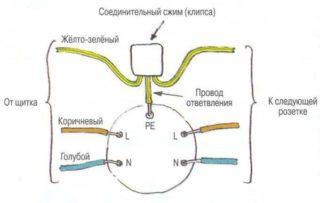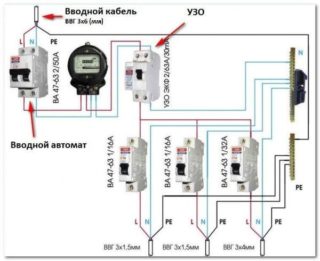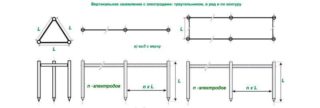Wiring safety is a prerequisite for any apartment or house. Grounding ensures the safe operation of electrical household appliances. It can also save a person from electric shock in case of breakdown of the phase conductor, violation of the insulating layer, with the accumulation of potential on metal parts. Before you make an outlet with grounding in the apartment or in the country, you need to understand the features of the power supply circuit in the apartment.
Why grounding and its types are needed
Grounding is a way to ensure the safety of people and household appliances. If electronic equipment breaks down, a charge builds up on the case. If a person touches a metal under voltage, an electric shock will occur. Grounding is used so that the current and potential from the housing go to the ground, do not cause harm to humans.
The electric network must consist of phase and zero. Additionally, a protective conductor - grounding can be connected. There are different schemes for connecting the grounding conductor - it can be absent, connected together with the neutral wire or stand out in a separate conductor.
Before choosing a grounding circuit, you need to find out which circuit is used in the house. It is laid even at the stage of building construction and wiring. In total, 6 schemes are distinguished, the most common include:
- TN-C. Electricity is supplied using a four-wire system. 3 cores extend from the phase conductor, the fourth wire is simultaneously zero and ground and is marked PEN (PE - ground, N - zero). Such a connection is unsafe for human life. In the event of a break in the ground, electrical appliances will stop working and the device will be energized. A potential will build up on the metal parts, which, if accidentally touched by a person, can lead to death. Installing protective devices like an RCD will not help. From such schemes, you need to go to TN-C-S, TN-S.
- TN-C-S. Similar to the previous circuit, here the power is supplied through a four-wire system. In a specific section of the PEN circuit, the wire breaks to ground and zero. A separate ground loop is installed at the branching point. For additional protection, an RCD must be provided in the circuit, since before the break, the conductor carries a potential threat.
- TT. This scheme is used in domestic networks. It is also a four-wire, in which 3 phases and one zero. Earth is missing, but it can be connected. The scheme is individually configured for each room.
- Ground circuit TN-C-S
- Ground circuit TN-C
- TT grounding circuit
After selecting a circuit, you can proceed to install the outlet
Connecting a ground outlet
To null the outlet with your own hands, you must follow the algorithm:
- phase and zero shutdown;
- power outage;
- fastening the contacts of the outlet to phase and zero;
- connecting the ground wire to the outlet;
- installation of a protective housing for the power outlet.
Before you make grounding in the outlet, you can determine the phase and zero using an indicator screwdriver or a tester. To the corresponding terminals of the outlet you need to connect the phase and zero from the wiring. The grounding conductor is connected to the terminal, which is located between the phase and zero contact.
If a grounding conductor is missing, grounding must not be performed.This will lead to the fact that when the zero disappears, a short circuit will occur, which can cause a fire or knock out traffic jams on the machine.
Grounding in the house
 In a private house, grounding is carried out in two ways:
In a private house, grounding is carried out in two ways:
- without grounding loop;
- with grounding loop.
In the absence of a contour, a steel pipe or metal parts on a wooden pole acts as a grounding structure. Using a similar method, two conditions must be observed - the minimum depth should be 1 meter and the current spreading should be no more than 4 Ohms per 220 V.
The grounding circuit has a distribution bus with which the entire system begins. All metal parts of the circuit must reliably connect to each other. For this, component welding is used.
When creating a path, the following errors are most often made:
- Unreliable parts connections. Poor contact leads to oxidation and rust formation, which can damage the circuit. It is important to make a quality connection.
- Choosing the wrong metal. Metal reinforcement is not suitable for connection - it disrupts the uniform distribution of currents.
You can not paint the outline. The paint does not protect it from corrosion, but only adds resistance, which reduces the effect of grounding.
Earth protection
If there is a grounding terminal in the riser wiring, earth is held to it. This is the easiest way. Otherwise, you need to choose a different method.
How to ground the outlet if there is no ground wire:
- Use of RCD. This method is used when there is no ground terminal in the wiring. RCD is installed on the line through which powerful household appliances with a metal case are connected (dishwashers or washing machines, water heaters). It must be borne in mind that the RCD does not provide full protection. This is only a temporary method before installing the ground loop.
- Installation of your own circuit. The creation of the grounding loop is carried out in several stages. First, select the place in which the ground electrode will be installed. You can’t put it in stony soil, a place of garbage discharge or unloading of building materials. Next, the scheme and materials are selected - the ground electrode can be installed vertically or horizontally, made of copper or steel, the type and size are selected. The earthing switch is installed in the trench. Its depth for horizontal installation is from 20 to 50 cm, for vertical - 100 cm. The assembled circuit is connected to a common loop and grounding resistance is measured. The last step is to connect all metal structures.
Grounding must be carried out correctly. There are dangerous ways that can lead to an irreparable situation:
- Ground cable connection to zero. If the zero core is broken, fire may occur.
- Grounding connection to a plumbing or heating system. In case of violation of the insulating layer, all elements will be energized. Touching them leads to negative consequences for health and life.
- Connection to fittings of the nearest high-voltage line. The potential from the line can go to the valve, because of which the protective properties of the insulator will be violated, overvoltage or other dangerous consequence will occur.
Such methods are strictly prohibited by the rules of the PUE and SNiP. When using the above methods, not only the owner of the apartment, but also his neighbors are in danger. In no case should you be grounded in this way.
